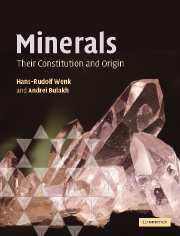Book contents
- Frontmatter
- Contents
- Preface
- Acknowledgments
- Figure credits
- Part I Structural features of minerals
- 1 Subject and history of mineralogy
- 2 Elements, bonding, simple structures, and ionic radii
- 3 The concept of a lattice and description of crystal structures
- 4 Macroscopic symmetries : crystal morphology
- 5 Crystal growth and aggregation
- 6 Isomorphism, polymorphism, and crystalline defects
- Part II Physical investigation of minerals
- Part III Variety of minerals and mineral-forming processes
- Part IV A systematic look at mineral groups
- Part V Applied mineralogy
- Appendices
- Glossary
- References
- Index
- Plate section
- References
5 - Crystal growth and aggregation
from Part I - Structural features of minerals
- Frontmatter
- Contents
- Preface
- Acknowledgments
- Figure credits
- Part I Structural features of minerals
- 1 Subject and history of mineralogy
- 2 Elements, bonding, simple structures, and ionic radii
- 3 The concept of a lattice and description of crystal structures
- 4 Macroscopic symmetries : crystal morphology
- 5 Crystal growth and aggregation
- 6 Isomorphism, polymorphism, and crystalline defects
- Part II Physical investigation of minerals
- Part III Variety of minerals and mineral-forming processes
- Part IV A systematic look at mineral groups
- Part V Applied mineralogy
- Appendices
- Glossary
- References
- Index
- Plate section
- References
Summary
Nucleation of crystals
Crystals have extraordinary properties of internal structure and external morphology. In several chapters, we have described these features in detail, with emphasis on symmetry. In this chapter we will take a broader look at how minerals form and how they present themselves in rocks. Unfortunately, most of the time, we do not observe ideal symmetrical polyhedra, as described in Chapter 4.
Crystal nucleation and growth generally begin when the concentrations of the elements in a crystal reach a certain level of supersaturation. This level can be reached by evaporation of a solvent as, for example, water in desert lakes and marine lagoons, with crystallization of evaporite minerals such as halite, sylvite, and gypsum. A temperature decrease may also initiate crystallization: examples are ice from liquid water and igneous minerals in cooling magmas. Pressure changes can cause spontaneous crystallization. For example, chalcedony, a fine-grained variety of quartz, is known to have formed in some tungsten deposits of northeastern Siberia under the rapid release of pressure. Finally, crystallization may be initiated by chemical reactions. An example is metamorphic schist that forms when mudstone, composed of clays, recrystallizes at elevated temperatures and pressures and new minerals form, such as mica, feldspar, quartz, and garnet.
The crystallization of minerals in volcanic lavas frequently occurs homogeneously throughout the lava volume. By contrast, crystal nucleation may occur on substrates of various kinds.
- Type
- Chapter
- Information
- MineralsTheir Constitution and Origin, pp. 84 - 101Publisher: Cambridge University PressPrint publication year: 2004



